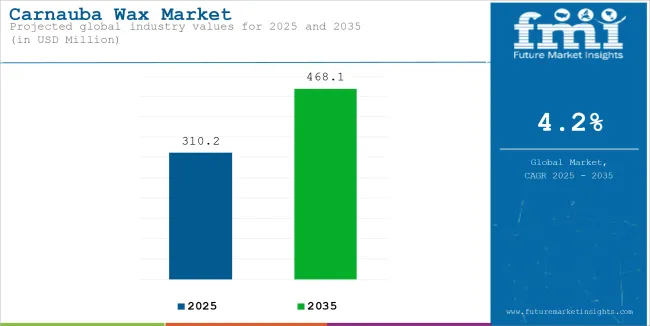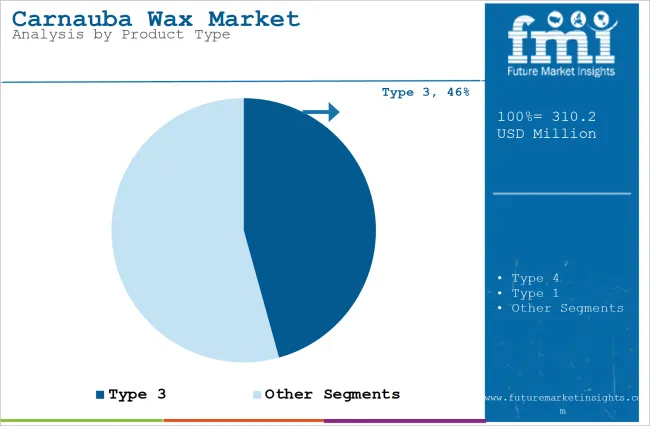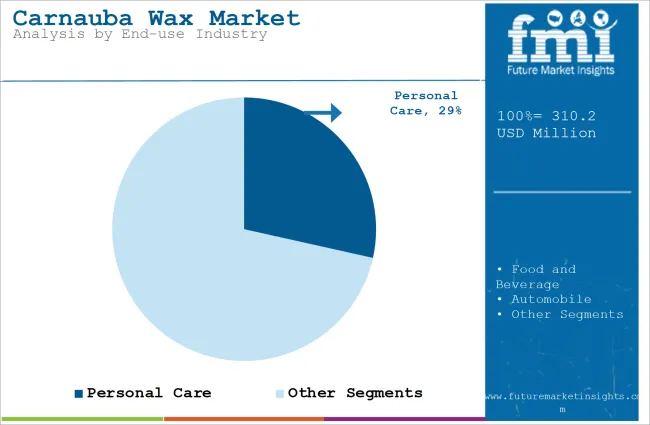The carnauba wax market is projected to grow from USD 310.2 million in 2025 to USD 468.1 million by 2035, registering a CAGR of 4.2% during the forecast period. Growth is being driven by the increasing demand for natural and plant-based waxes in cosmetics, food coatings, automotive polishes, and pharmaceutical excipients.

Market Metrics
| Metrics | Values |
|---|---|
| Industry Size 2025 | USD 310.2 million |
| Industry Value 2035 | USD 468.1 million |
| CAGR 2025 to 2035 | 4.2% |
Carnauba wax, derived from the leaves of the Copernicia prunifera palm, is valued for its high melting point, gloss finish, and biodegradability. Its growing adoption in vegan cosmetics, organic food packaging, and sustainable polishes has made it an attractive ingredient across industries. Rising demand in Asia-Pacific and increased emphasis on eco-friendly ingredients is accelerating global market expansion.
The market is being influenced by the transition from synthetic waxes to plant-based alternatives, growing consumer preference for non-toxic surface protectants, and regulations favoring biodegradable materials in industrial, food, and personal care applications. The carnauba wax market is projected to reach USD 310.2 million in 2025.
Within the broader natural waxes market, carnauba wax holds approximately 25-30% share, driven by demand for renewable, plant-based materials. In the specialty chemicals market, it represents less than 0.5%, valued for its durability and glossy finish in coatings and compounds.
Within the cosmetic ingredients market, it contributes about 1-2%, commonly used in lipsticks, balms, and emulsions. In the food additives market, its share is estimated at 0.5-1%, serving as a glazing agent in candies and pills. Carnauba wax also makes up around 2-3% of the industrial waxes market, used extensively in automotive waxes, polishes, and surface treatment formulations.
Leading producers are investing in supply chain sustainability, organic certification, and processing technology upgrades to enhance purity and meet diverse application requirements. Carnauba wax's status as a GRAS (Generally Recognized As Safe) food additive and its compliance with EU and FDA standards further supports its use in confectionery glazes, nutraceutical coatings, and cosmetic emulsions.
The below table presents a comparative assessment of the variation in CAGR over six months for the base year (2024) and current year (2025) for the global carnauba wax industry.
This analysis reveals crucial shifts in performance and indicates revenue realization patterns, thus providing stakeholders with a better vision of the growth trajectory over the year. The first half of the year, or H1, spans from January to June. The second half, H2, includes the months from July to December.
| Particular | Value CAGR |
|---|---|
| H1 (2024 to 2034) | 3.6% |
| H2 (2024 to 2034) | 3.7% |
| H1 (2025 to 2035) | 4.0% |
| H2 (2025 to 2035) | 4.2% |
In the first half (H1) of the decade from 2025 to 2035, the business is predicted to surge at a CAGR of 3.6%, followed by a higher growth rate of 3.7% in the second half (H2) of the same decade. Moving into the subsequent period, from H1 2025 to H2 2035, the CAGR is projected to increase to 4.0% in the first half and remain considerably high at 4.2% in the second half. In the first half (H1) the sector witnessed an increase of 25 BPS while in the second half (H2), the business witnessed a decrease of 15 BPS.
The carnauba wax market is experiencing notable growth, with Type 3 product category leading with a 45.7% market share in 2025. Personal care applications are expected to capture 28.5%, and flakes form will dominate at 40%. These segments are driven by demand across industries such as food and beverage, automobile, personal care, pharmaceuticals, and others.
Type 3 carnauba wax is projected to dominate the market with a 45.7% share in 2025.
This product type is highly valued for its versatility and performance in various applications, particularly within the personal care, food, and pharmaceutical sectors. Manufacturers like Foncepi Group and Brasil Ceras are focusing on enhancing the properties of Type 3 wax to meet the increasing demand for high-quality, multi-functional wax products. The growing adoption of Type 3 wax can be attributed to:

The personal care sector is expected to capture 28.5% of the carnauba wax market by 2025.
The market is driven by the rising demand for natural, sustainable ingredients in cosmetic and skincare products. Carnauba wax is known for its smooth application and durability, making it ideal for use in lip balms, hair products, and lotions. Key players like Strahl & Pitsch, Inc. and Multiceras are investing in carnauba wax formulations that meet the growing consumer demand for clean beauty products. This sector’s growth is fueled by:

Flakes are anticipated to represent 40% of the carnauba wax market in 2025.
The demand for flakes form is driven by its convenience and ease of incorporation into various formulations across industries such as food, automobile, and personal care. Carnauba wax flakes are highly favored in polishing, coating, and cosmetic applications due to their uniformity and smooth texture. Key market players, including Kahl GmbH & Co. KG and Alpha Wax, continue to innovate and expand their offerings of carnauba wax flakes. The growth of flakes form is supported by:
Redefining Product Portfolios to Captivate Evolving Consumer Needs in Brazilian Wax Industry
Carnauba wax has proven to be rather beneficial in diversifying the range of services a brand can provide. For instance, Meguiar's is a big brand that focuses on automotive care but because of Brazilian wax, they can also focus on their household and industrial waxes. With the recent interest in multifunctional and eco-friendly products, the demand is only expected to grow.
For instance, Cera Ypiranga has expanded its empire outside the USA and is a manufacturer of Brazilian wax. They have also given attention to the naturally orientated formulas by creating lip balms and skin creams with this palm wax in them.
Furthermore, another interesting brand is Fontenelle which has targeted eco-friendly furniture polishes and used Copernicia wax in candles which are equally suited to modern households. It is safe to say that expanding into different household items also brings palm wax into the limelight.
Manufacturers are Embracing the Ethical Sourcing and Community Engagement
To respond to the high demand of consumers for ethically produced items, carnauba wax suppliers are making sustainable development goals their priority. Foncepi among others has advanced sustainable practices of harvesting wax so that palm trees and the environment are not destroyed.
Moreover, they work hand in hand with the Brazilian communities offering them good pay and engaging in social activities. This strategy helps to build and improve the company's image while responding to the consumers' demand for environmentally friendly products.
Koster Keunen in the same manner has adopted a policy of acquiring supplies sustainably underscoring the traceability of products and care for the environment. These companies are in step with the rising consumers' need for top-notch products that are made in an ethically responsible manner, thereby assuring industry presence for many years.
Firms are Investing in Research and Development to Expand Versatile Applications
The industry for Brazilian wax is experiencing a significant change owing to the increase in research and development activities. Companies such as Poth Hille have opened specialized research and development branches to find new uses and sharpen already existing applications.
For example, Poth Hille is looking into reengineering palm wax for the pharmaceutical industry to improve the formulation and enhance tablet coating. This shift towards innovation is a result of the consumer trend in various markets to seek natural high-performance ingredients.
Moreover, Strahl & Pitsch intend to use palm wax for food and packaging to replace synthetic materials with green ones. These endeavors not only satisfy the increasing global appetite for more green and versatile products but also help these companies to remain one of the most innovative leaders in the industry.
If there is continuous research and development, and investment, the industry will experience new opportunities, and enhanced product specifications.
The business ecosystem operates in a peculiar way, i.e., it has a mixture of organized and unorganized sector. The organized sector comprises corporations that operate at an international level and are externally certified against quality and sustainability requirements.
Such companies as Koster Keunen and Strahl & Pitsch focus considerably on research and development to diversify and increase their portfolio of products. They have strong distribution channels and can cater to bulk requirements from the cosmetics, food, and pharmaceutical industries, and others.
For example, the Koster Keunen company has a wide range of products and is focused on quality and environmental concerns, which allows it to be competitive still in the market that offers products for the most sophisticated and regulated industries.
On the other hand, the unorganized sector includes local producers who are comparatively small, so they have minimal infrastructural and other resources. They are in most cases geared towards satisfying the local segments. Companies such as Carnauba do Brasil Ltda. and Pontes Industria de Cera Ltda. are examples in this category as they specialize in the provision of palm wax, but only for the domestic markets.
These producers are important in the total supply chain, however, often, they tend to operate under the radar and have difficulties in scaling up their output or quality control.
The structural composition of the palm wax industry suggests that there exists a healthy mix of big, organized firms, that are the innovation and quality leaders with many smaller unorganized producers, who focus on being cost-efficient and meeting the changes in demand.
The following table shows the estimated growth rates of the top three territories. USA and Brazil are set to exhibit high consumption, recording CAGRs of 4.2% and 3.8%, respectively, through 2035.
| Countries | CAGR 2025 to 2035 |
|---|---|
| USA | 4.2% |
| Brazil | 3.8% |
| Germany | 4.8% |
| China | 5.3% |
| Japan | 5.9% |
The American sector is set to broaden since several factors address the distinctive requirements. One such trend is the keen interest in natural and organic substitutes for synthetic waxes, which is mostly in the automotive and beauty sectors.
Carnauba wax manufacturers are now marketing the green nature of their products, and companies such as Koster Keunen have seized the opportunity, appealing to the environmentally aware American audience. Moreover, there is an increasing trend towards the use of palm wax in cosmetics and skincare due to the greater sales of natural and organic personal care products.
Instead, Ceara Wax develops advanced technology that uses natural wax that provides shine and gloss that lasts to meet the rising demand for clean and eco-friendly beauty products among American consumers.
Brazil now stands out as among the foremost growers and exporters of the carnauba palm tree for it has been in the business for a long period. For example, companies like Fontes Agroindústria have combined indigenous knowledge with Brazilian wax to meet international and local needs.
Furthermore, the presence of a strong supply chain and marketing in Brazil has helped palm wax manufacturers to supply the growing requirements of different industries. These include the automotive industry, which favors Brazilian wax for its effective use as a polish and sealant.
On top of that, the development of Brazil’s cosmetic and personal care industries has spurred the use of this wax as a natural and able substitute that has boosted the growth in Brazil.
Due to the country’s focus on environmental and eco-friendly concepts, the German industry is witnessing significant growth and emerging as a key industry for suppliers. Palm wax is a product that has growing importance in Germany among consumers who are more driven by environmental factors.
In the case of the German automotive industry, this wax was remarkably adopted as a product used for the care and detailing of automobiles because of its ability to protect and increase the shine of the exterior of cars.
This has increased the demand for Brazilian wax by car manufacturers and detailing companies due to its ability to enhance appearance and provide long-lasting protection from the elements and environmental effects.
As a result, this wax is now a key constituent in the premium car care industry in Germany where customers are ready to spend in products that enhance the look of their cars and are environmentally friendly.
The carnauba wax market is dominated by Brazilian producers such as Foncepi Group, Brasil Ceras, and Pontes Indústria de Cera, which control a significant share of raw material extraction and refining due to their proximity to native Copernicia prunifera palms. These companies lead with consistent supply, quality control, and sustainability practices, serving cosmetics, food, automotive, and pharmaceutical industries.
Key international players like Strahl & Pitsch, Inc., Multiceras, and Kahl GmbH & Co. KG specialize in blending, refining, and custom-formulating carnauba wax for industrial and specialty applications. Emerging suppliers such as Alpha Wax, Carnaúba do Brasil, Arjun Beeswax, and Agrocera are gaining attention through traceability efforts, ethical sourcing, and expanding exports to Europe, North America, and Asia-Pacific.
Recent Industry Developments
As per product type, the industry has been categorized into Type 1, Type 3, and Type 4.
This segment is further categorized into Flakes, Lumps, Powder, Pastilles Form.
This segment is further categorized into Food and Beverage, Automobile, Personal Care, Pharmaceuticals, and Others.
Industry analysis has been carried out in key countries of North America, Latin America, Western Europe, Eastern Europe, Balkans & Baltic, Russia & Belarus, Central Asia, East Asia, South Asia & Pacific, and the Middle East & Africa.
The global industry is estimated at a value of USD 310.2 million in 2025.
Sales increased at 3.7% CAGR between 2020 and 2024.
Some of the leaders in this industry include Foncepi Group, Brasil Ceras, Pontes Indústria de Cera, Strahl & Pitsch, Inc., Multiceras, Kahl GmbH & Co. KG, Alpha Wax, Carnaúba do Brasil, Arjun Beeswax, and Agrocera.
The North American territory is projected to hold a dominant revenue share over the forecast period.
The industry is projected to grow at a forecast CAGR of 4.2% from 2025 to 2035.
Explore Similar Insights

Thank you!
You will receive an email from our Business Development Manager. Please be sure to check your SPAM/JUNK folder too.